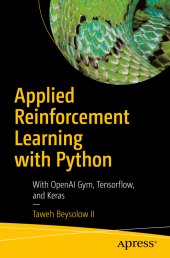 Neuerscheinungen 2019Stand: 2020-02-01 |
Schnellsuche
ISBN/Stichwort/Autor
|
Herderstraße 10
10625 Berlin
Tel.: 030 315 714 16
Fax 030 315 714 14
info@buchspektrum.de |

Taweh Beysolow
Applied Reinforcement Learning with Python
With OpenAI Gym, Tensorflow, and Keras
1st ed. 2019. xv, 168 S. 47 SW-Abb. 235 mm
Verlag/Jahr: SPRINGER, BERLIN; APRESS 2019
ISBN: 1-484-25126-1 (1484251261)
Neue ISBN: 978-1-484-25126-3 (9781484251263)
Preis und Lieferzeit: Bitte klicken
Beginning-Intermediate
Delve into the world of reinforcement learning algorithms and apply them to different use-cases via Python. This book covers important topics such as policy gradients and Q learning, and utilizes frameworks such as Tensorflow, Keras, and OpenAI Gym.
Applied Reinforcement Learning with Python introduces you to the theory behind reinforcement learning (RL) algorithms and the code that will be used to implement them. You will take a guided tour through features of OpenAI Gym, from utilizing standard libraries to creating your own environments, then discover how to frame reinforcement learning problems so you can research, develop, and deploy RL-based solutions.
What You´ll Learn
Implement reinforcement learning with Python
Work with AI frameworks such as OpenAI Gym, Tensorflow, and Keras
Deploy and train reinforcement learning-based solutions via cloud resources
Apply practical applications of reinforcement learning
Who This Book Is For
Data scientists, machine learning engineers and software engineers familiar with machine learning and deep learning concepts.
Chapter 1: Introduction to Reinforcement Learning Chapter Goal: Inform the reader of the history of the field, its current applications, as well as generally discussing the outline of the text and what the reader can expect to learn No of pages 10 Sub -Topics 1. What is reinforcement learning? 2. History of reinforcement learning 3. Applications of reinforcement learning
Chapter 2: Reinforcement Learning Algorithms Chapter Goal: Establishing an understanding with the reader about how reinforcement learning algorithms work and how they differ from basic ML/DL methods. Practical examples to be provided for this chapter
No of pages: 50
Sub - Topics 1. Tabular solution methods 2. Approximate solution methods
Chapter 3: Q Learning Chapter Goal: In this chapter, readers will continue to build on their understanding of RL by solving problems in discrete action spaces No of pages : 40 Sub - Topics: 1. Deep Q networks 2. Double deep Q learning
Chapter 4: Reinforcement Learning Based Market Making Chapter Goal: In this chapter, we will focus on a financial based use case, specifically market making, in which we must buy and sell a financial instrument at any given price. We will apply a reinforcement learning approach to this data set and see how it performs over time No of pages: 50 Sub - Topics: 1. Market making 2. AWS/Google Cloud 3. Cron
Chapter 5: Reinforcement Learning for Video Games Chapter Goal: In this chapter, we will focus on a more generalized use case of reinforcement learning in which we teach an algorithm to successfully play a game against computer based AI. No of pages: 50 Sub - Topics: 1. Game background and data collection


